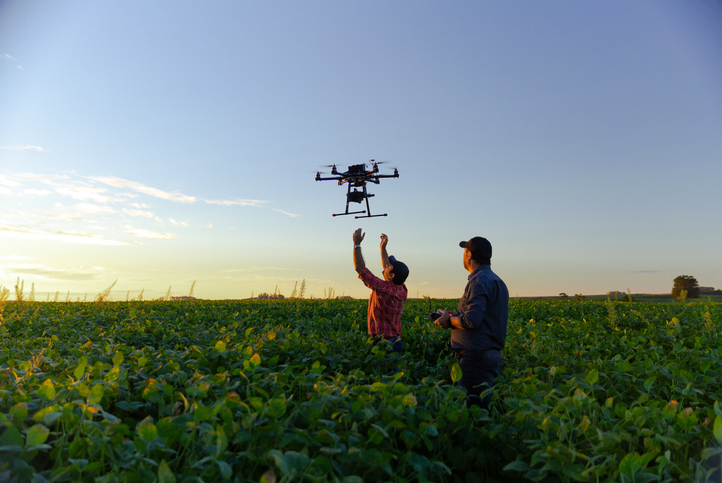The need for affordable, reliable, sustainable, and modern energy is now more critical than ever because of the climate crisis—which is estimated to push up to 130 million people into poverty over the next ten years and continue to cause more unpredictable natural disasters, such as cyclones, flooding, earthquakes, landslides, tsunamis, and volcanic eruptions.
The power outages caused by these natural disasters can last several hours, days, and weeks. Microgrids can satisfy wide-ranging demands via their variable solutions, from off-grid to on-grid applications. The digital twin (DT) concept opens a new dimension in the energy system to break down data silos and carry out seamless functional processes in data analysis, modeling, simulation, and artificial intelligence (AI)-driven decision-making.
In an article published in IEEE Power and Energy Magazine, researchers provide a clear vision of DTs and their use with microgrids, focusing on different aspects of DT applications for microgrids.
How to Build Modern Microgrids
According to the article, microgrids have been functioning for decades to provide a reliable power supply for rural electrification, critical infrastructure in medical facilities, and sustainable solutions for communities, buildings, and data centers. To build modern microgrids, it is necessary to enable them to function as a real-time monitoring and controllable unit with three important advantages:
- Flexible to accommodate advanced digital technologies and digest the uncertainties of the grid edge to form a scalable cyber-physical network.
- Resilient to run autonomously in islanded mode, with reliable and efficient energy supply to customers in the face of various external or internal disturbances, failures, and disasters.
- Smart to deal with multidisciplinary optimization problems via varying infrastructure and operating conditions to achieve a continuous balance of demand and supply.
Digital twin technology can establish a data-centric framework that can cut across all domains and break down data silos, enabling seamless decision-making that improves the costs and benefits for end users and different market players.
Real-Time Energy Management System
The massive integration of distributed energy resources (DERs) brings significant challenges for power system operators regarding stability, protection, planning, and market operations.
They also offer opportunities to provide valuable services to increase overall system flexibility, reduce energy costs, and support attaining carbon neutrality targets by 2050.
Creating a dynamically balanced local energy network is necessary to maximize capacity and achieve grid edge reliability. Up-to-date models, accurate data, and automated controls are the foundation to maximize operational excellence. The researchers present an overview of DT solutions for microgrid control with three control levels that support a wide range of services, from the operation of DERs to economic power flow management.
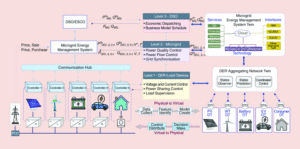
DT solutions for microgrid control and energy management systems.
Microgrid Protection
The complexity of integrated DERs presents unique protection challenges to detect and respond to failures quickly and accurately. As noted by the researchers, DTs make it possible to reflect the physical conditions of the system and its components with real-time monitoring to access the system's behavior, recognize anomalies, and then take protective actions autonomously. A cloud-based solution for microgrid protection is a pivotal strategy for addressing the multifaceted challenges encountered in modern microgrid systems.
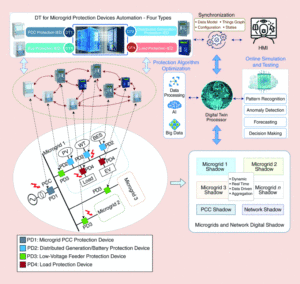
The DT framework and working principles for microgrid protection.
The researchers explain why the DT framework excels in handling bidirectional fault current flow, ensuring accurate fault identification and response. With the cloud-based solution, the DT creates a networked context-aware ecosystem capable of capturing a real-time operation snapshot to help identify and respond to the correct fault events. The paper also discusses the main blocks and functions of the DT-enabled microgrid protection system.
Predictive and Prescriptive Maintenance of Microgrids
The ever-increasing complexity of microgrids necessitates advanced operation management and maintenance strategies. As the researchers noted, a timely maintenance schedule and execution help prolong the lifetime of components and reduce lifecycle cost, maintenance cost, and the cost imposed by out-of-service penalties. Safety, service quality, and cost are essential for developing maintenance strategies.
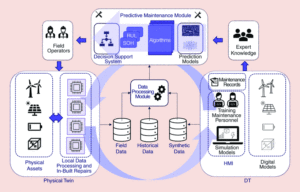
The DT framework for microgrid predictive and prescriptive maintenance.
The researchers outline several maintenance opportunities that using digital twin technology allows for. Depending on the application, in-house health monitoring systems inside the physical components and remote monitoring systems can be developed using fast and reliable communication systems and cloud platforms.
Real-Time Simulation and Testing of Microgrids
With the increasing use of renewable energy, microgrids now have higher flexibility requirements and are becoming more complex. DTs are powerful tools capable of improving the simulated efficiency of multiple aspects of microgrids with high-performance IoT communication, rich modeling exchanges, and AI-based optimization. The article highlights new features and capabilities that DTs can add to microgrids:
- Microgrid DTs create a high-fidelity snapshot of the physical microgrid, significantly facilitating real-time system observation.
- A microgrid DT bridges the physical microgrid and its digital counterpart with high-performance IoT communication.
- With AI, a microgrid DT is a data-driven and self-adaptive framework, continuously tuning the parameters to achieve model enhancement learning.
- A microgrid DT can provide in-depth observation and describe inner component interactions in great detail.
- Integrating a system-specific evaluator allows a microgrid DT to identify abnormal operations and malfunctions to achieve high predictive maintenance capability and sustainable decision-making.
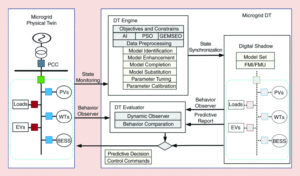
An architecture for microgrid real-time simulation and testing with a DT.
Future Directions
DTs help establish a data-centric framework capable of cutting across all domains, enabling seamless decision-making that improves the costs and benefits for end users and market players. As analyzed in this article, DTs are built to support various microgrid applications, providing a data-centric framework that transcends traditional boundaries. It is essential to inherit interactive and higher-level twins from these functional twins to embark on the journey toward an advanced microgrid distribution management system. These encompass software-defined automation, networking, storage, and data center capabilities, which empower microgrid management systems to operate efficiently and effectively in an increasingly dynamic and data-driven landscape.
Interested in learning more about Digital Twins and modern energy? IEEE offers continuing education with these course programs to smartly implement digital tools into your organization:
- Digital Transformation: Moving Toward a Digital Society Course Program
- Introduction to IEEE Standard 1547TM-2018: Connecting Distributed Energy Resources Course Program
- Minigrids in Africa Course Program
Interested in acquiring full-text access to this collection for your entire organization? Request a free demo and trial subscription for your organization.


